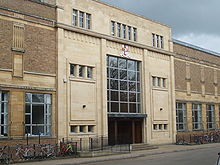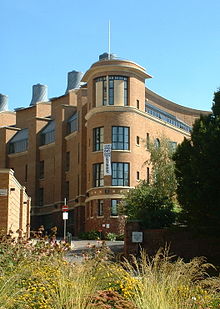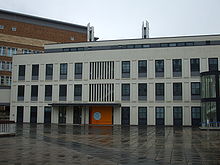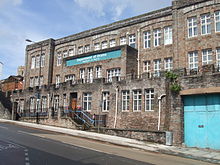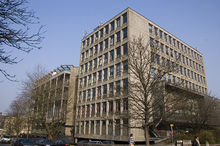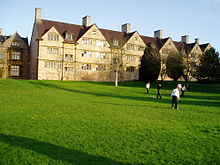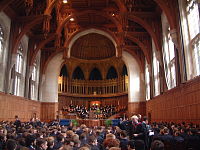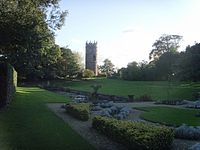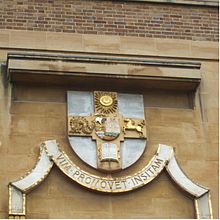- University of Bristol
-
University of Bristol 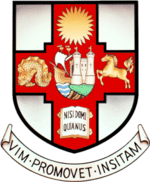
Latin: Universitas Bristolliensis (Bris.) Motto Vim promovet insitam Motto in English "[Learning] promotes one's innate power" – from Horace, Ode 4.4[1] Established 1909 by Royal Charter
1876 - University College[2]Type Public Endowment £43.1m[3] Chancellor Baroness Hale of Richmond[4] Vice-Chancellor Prof Eric Thomas[5] Visitor The Lord President of the Council ex officio[6] Admin. staff 5,809[7] Undergraduates 12,963[7] Postgraduates 5,181[7] Location Bristol, England, UK
51°27′23″N 02°36′16″W / 51.45639°N 2.60444°WCoordinates: 51°27′23″N 02°36′16″W / 51.45639°N 2.60444°WCampus Urban Colours Pantone 187[8] Affiliations Russell Group
Coimbra Group
Worldwide Universities Network
Universities UKWebsite bristol.ac.uk 
The University of Bristol (informally Bristol) is a public research university located in Bristol, United Kingdom.[9] One of the so-called "red brick" universities, it received its Royal Charter in 1909,[10] although its predecessor institution, University College, Bristol, had been in existence since 1876.[11]
The University is widely regarded as one of the best in the United Kingdom and enjoys a strong global reputation, consistently being ranked as one of the top 10 in Europe.[12] It is the most popular university in the UK, with over 14 applicants vying for each place, and average A-level attainment of successful entrants of 4 grade As.[13] For some of the most popular courses, such as Economics and Law, the applicant to place ratio is often as high as 40:1.[14] The University had a turnover of £373m in 2009/10 and is the largest independent employer in Bristol.[15]
Bristol is associated with 11 Nobel Laureates, and current academics include 18 Fellows of the Academy of Medical Sciences, 10 Fellows of the British Academy, 13 Fellows of the Royal Academy of Engineering and 31 Fellows of the Royal Society.[16]
Bristol is a member of the Russell Group,[17] the European-wide Coimbra Group[18] and the Worldwide Universities Network, of which the University's Vice-Chancellor Prof. Eric Thomas was Chairman (2005–2007).[19]
Contents
History
Foundation
The earliest antecedent of the university was the engineering department of the Merchant Venturers’ Technical College (founded as a school as early as 1595) which became the Engineering faculty of Bristol University.[20] The University was also preceded by Bristol Medical School (1833) and University College, Bristol, founded in 1876,[11] where its first lecture was attended by only 99 students.[21] The University was able to apply for a Royal Charter due to the financial support of the Wills and Fry families, who made their fortunes in tobacco plantations and chocolate, respectively. The Wills Family made a vast fortune from the tobacco industry and gave generously to the city and University. The Royal Charter was gained in May 1909, with 288 undergraduates and 400 other students entering the University in October 1909. Henry Overton Wills III became its first chancellor.[11] The University College was the first such institution in the country to admit women on the same basis as men.[11] However, women were forbidden to take examinations in medicine until 1906.[22]
There shall be from henceforth for ever in Our said City of Bristol a University...
King Edward VII, Charter of Incorporation of the University of Bristol, 4 December 1909[23][dead link] Historical development
Since the founding of the University itself in 1909, it has grown considerably and is now one of the largest employers in the local area, although it is smaller by student numbers than the nearby University of the West of England.[24] Bristol does not have a campus but is spread over a considerable geographic area. Most of its activities, however, are concentrated in the area of the city centre, referred to as the "University Precinct". It is a member of the Russell Group of research-led UK universities, the Coimbra Group of leading European universities and the Worldwide Universities Network (WUN).
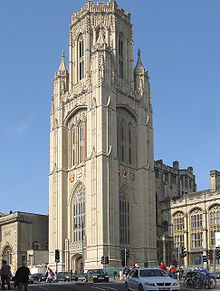 The Wills Memorial Building (School of Earth Sciences) on Park Street, Bristol. The tower was cleaned in 2006-2007.
The Wills Memorial Building (School of Earth Sciences) on Park Street, Bristol. The tower was cleaned in 2006-2007.
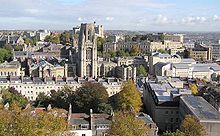 Most of the buildings here are used by the University. The Wills Memorial Building is left of centre. Viewed from the Cabot Tower on Brandon Hill
Most of the buildings here are used by the University. The Wills Memorial Building is left of centre. Viewed from the Cabot Tower on Brandon Hill
Early years
After the founding of the University College in 1876, Government support began in 1889. After mergers with the Bristol Medical School in 1893 and the Merchant Venturers' Technical College in 1909,[25] this funding allowed the opening of a new Medical School and an Engineering School—two subjects that remain among the University's greatest strengths. In 1908, gifts from the Fry and Wills families, particularly £100,000 from Henry Overton Wills III (£6m in today's money), were provided to endow a University for Bristol and the West of England, provided that a Royal Charter could be obtained within two years. In December, 1909, the King granted such a Charter and erected the University of Bristol.[23] Henry Wills became its first Chancellor and Conwy Lloyd Morgan the first Vice-Chancellor.[26][dead link] Wills died in 1911 and in tribute his sons George and Harry built the Wills Memorial Building, starting in 1913 and finally finishing in 1925.[27] Today, it houses parts of the academic provision for earth sciences and law, and graduation ceremonies are held in its Great Hall. The Wills Memorial Building is a Grade II* listed building.[28]
In 1920, George Wills bought the Victoria Rooms and endowed them to the University as a Students' Union.[11] The building now houses the Department of Music and is a Grade II* listed building.[29]
At the point of foundation, the University was required to provide for the local community. This mission was behind the creation of the Department of Extra-Mural Adult Education in 1924 to provide courses to the local community. This mission continues today; a new admissions policy specifically caters to the 'BS' postcode area of Bristol.[30]
Among the famous names associated with Bristol in this early period is Paul Dirac, who graduated in 1921 with a degree in engineering, before obtaining a second degree in mathematics in 1923 from Cambridge. For his subsequent pioneering work on quantum mechanics, he was awarded the 1933 Nobel Prize for Physics.[31] Later in the 1920s, the H.H. Wills Physics Laboratory was opened by Ernest Rutherford.[32] It has since housed several Nobel Prize winners: Cecil Frank Powell (1950);[33] Hans Albrecht Bethe (1967);[34] and Sir Nevill Francis Mott (1977).[35] The Laboratory stands on the same site today, close to the Bristol Grammar School and the city museum.
Sir Winston Churchill became the University's third Chancellor in 1929, serving the University in that capacity until 1965.[11] He succeeded Richard Haldane who had held the office from 1912 following the death of Henry Wills.[22][26]
During World War II, the Wills Memorial was bombed, destroying the Great Hall and the organ it housed.[11] It has since been restored to its former glory, complete with oak panelled walls and a new organ.
Post-war development
In 1946, the University established the first drama department in the country.[11] In the same year, Bristol began offering special entrance exams and grants to aid the resettlement of servicemen returning home. Student numbers continued to increase, and the Faculty of Engineering eventually needed the new premises that were to become Queen's Building in 1955. This substantial building housed all of the University's engineers until 1996, when Electrical Engineering and Computer Science moved over the road into the new Merchant Venturers' Building to make space for these rapidly expanding fields. Today, Queen's Building caters for most of the teaching needs of the Faculty and provides academic space for the "heavy" engineering subjects (civil, mechanical, and aeronautical).
With unprecedented growth in the 1960s, particularly in undergraduate numbers, the Student's Union eventually acquired larger premises in a new building in the Clifton area of the city, in 1965. This building was more spacious than the Victoria Rooms, which were now given over to the Department of Music. The new Union provides many practice and performance rooms, some specialist rooms, as well as three bars: Bar 100; the Mandela (also known as AR2) and the Avon Gorge. Whilst spacious, the Union building is thought by many to be ugly[36] and out of character compared to the architecture of the rest of the Clifton area, having been mentioned in a BBC poll to find the worst architectural eyesores in Britain.[37] The University has proposed relocating the Union to a more central location as part of its development 'masterplan'.[38] More recently, plans for redevelopment of the current building have been proposed.[39]
The 1960s were a time of considerable student activism in the United Kingdom, and Bristol was no exception. In 1968, many students marched in support of the Anderson Report, which called for higher student grants. This discontent culminated in an 11-day sit-in at the Senate House (the administrative headquarters of the University).[11] A series of Chancellors and Vice-Chancellors led the University through these decades, with Henry Somerset, 10th Duke of Beaufort taking over from Churchill as Chancellor in 1965 before being succeeded by Dorothy Hodgkin in 1970 who spent the next 18 years in the office.[26]
As the age of mass higher education dawned, Bristol continued to build its student numbers. The various undergraduate residences were repeatedly expanded and, more recently, some postgraduate residences have been constructed. These more recent ventures have been funded (and are run) by external companies in agreement with the University.
Since 1988, there have been only two further Chancellors: Sir Jeremy Morse, then chairman of Lloyds Bank who handed over in 2003 to Brenda Hale, the first female Law Lord.[22][26]
One of the few Centres for Deaf Studies in the United Kingdom was established in Bristol in 1981, followed in 1988 by the Norah Fry Centre for research into learning difficulties. Also in 1988, and again in 2004,[40] the Students' Union AGM voted to disaffiliate from the National Union of Students (NUS). On both occasions, however, the subsequent referendum of all students reversed that decision and Bristol remains affiliated to the NUS.
In 2002, the University was involved in argument over press intrusion after details of the son of then-Prime Minister Tony Blair's application to university were published in national newspapers.
As the number of postgraduate students has grown (particularly the numbers pursuing taught Master's Degrees), there eventually became a need for separate representation on University bodies and the Postgraduate Union (PGU) was established in 2000.[41][dead link] Universities are increasingly expected to exploit the intellectual property generated by their research activities and, in 2000, Bristol established the Research and Enterprise Division (RED) to further this cause (particularly for technology-based businesses). In 2001, the university signed a 25-year research funding deal with IP2IPO, an intellectual property commercialisation company.[42] In 2007, research activities were expanded further with the opening of the Advanced Composites Centre for Innovation and Science (ACCIS) and The Bristol Institute for Public Affairs (BIPA).
In 2002, the University opened a new Centre for Sports, Exercise and Health in the heart of the University precinct.[43] At a cost, local residents are also able to use the facilities.[44][dead link]
Expansion of teaching and research activities continues. In 2004, the Faculty of Engineering completed work on the Bristol Laboratory for Advanced Dynamics Engineering (BLADE). This £18.5m project[45][dead link] provides cutting-edge technology to further the study of dynamics and is the most advanced such facility in Europe. It was built as an extension to the Queen's Building and was officially opened by Queen Elizabeth II in March 2005.
In January, 2005, The School of Chemistry was awarded £4.5m by the Higher Education Funding Council for England to create Bristol ChemLabS: a Centre for Excellence in Teaching & Learning (CETL),[46] with an additional £350k announced for the capital part of the project in February, 2006. Bristol ChemLabS stands for Bristol Chemical Laboratory Sciences; it is the only Chemistry CETL in the UK.
September 2009 saw the opening of the University's Centre for Nanoscience and Quantum Information. This £11 million state of the art building is dubbed as the quietest building in the world and has other technologically sophisticated features such as self-cleaning glass. Advanced research into quantum computing, nanotechnology, materials and other disciplines are being undertaken in the building.[47]
There is also a plan to significantly redevelop the centre of the University Precinct in the coming years.[48] The first step began in September 2011, with the start of construction of a state-of-the-art Life Sciences building. In a time of heavy financial pressures on all Universities, this £50 million project is a clear statement that Bristol is committed to world class research and teaching facilities.[49]
2003 admissions controversy
Main article: University of Bristol admissions controversyThe University has been regarded as being elitist by some commentators,[50] taking 41% of its undergraduate students from non-state schools, according to the most recent 2009/2010 figures, despite the fact that such pupils make up just 7% of the population[51] and 18% of 16+ year old pupils across the UK.[52] The high ratio of undergraduates from non-state school has led to some tension at the university.[53] In late February and early March 2003, Bristol became embroiled in a row about admissions policies, with some private schools threatening a boycott[54] based on their claims that, in an effort to improve equality of access, the University was discriminating against their students. These claims were hotly denied by the University.[55] In August, 2005, following a large-scale survey, the Independent Schools Council publicly acknowledged that there was no evidence of bias against applicants from the schools it represented.[56] The University has a new admissions policy,[30] which lays out in considerable detail the basis on which any greater or lesser weight may be given to particular parts of an applicant's backgrounds—in particular, what account may be taken of which school the applicant hails from. This new policy also encourages greater participation from locally resident applicants.
Academic reputation
Bristol is known for academics, excellent facilities, and a desirable location. League tables usually place Bristol within the top ten universities in the United Kingdom and it attracts many academically gifted students. For example, the 21st July 2011 edition of Times Higher Education reported that Bristol was fifth in a UK league table for the highest proportion of students with A-level grades AAB or better. Internationally, the 2011 QS World University Rankings[57] placed Bristol at 30th overall in the world, moving up four places from its position in the 2009 THE-QS World University Rankings (in 2010 Times Higher Education World University Rankings and QS World University Rankings parted ways to produce separate rankings). The rankings also placed Bristol at 15th in the world in terms of reputation with employers, placing higher than several American Ivy League universities, including Princeton University, Cornell and UPenn.[58] Another international ranking, the Shanghai Jiao Tong University Academic Ranking of World Universities, placed Bristol 62nd globally in 2007.[59] According to data published in The Telegraph Bristol has the third-highest percentage of 'good honours' of any UK university, behind Oxford and Cambridge.[60] In the 2010 Centre for Higher Education's Development's Excellence Rankings, Bristol is one of only four UK Universities (Oxford, UCL and Manchester) to be rated Excellent in all seven departments.[61]
However Bristol gained some of the lowest scores for student satisfaction in the 2008 National Student Survey[62] and The Daily Telegraph have reported of student complaints about teaching quality.[63] This has led to the recent deterioration in the University's rankings in the UK league tables, although it still ranks highly in international league tables.
The following courses offered by University of Bristol, managed to reach top 5 in the Times ranking (2008): Computer Science(3rd); Electrical and Electronic Engineering(3rd); Civil Engineering(5th); Biological Sciences(3rd); Mathematics (3rd); and Psychology (4th). Furthermore, the QS World University Rankings place Bristol in the world's top 100 universities for all subject areas in 2011: Arts and Humanities (57th), Natural Sciences (40th), Engineering & IT (83rd), Social Sciences (65th) and Life Sciences (70th).[64] A further breakdown of the QS World University Natural Sciences Ranking shows the following: Earth Sciences (25th),[65] Mathematics (35th),[66] Environmental Sciences (39th),[67] Physics (41st),[68] and Chemistry (48th).[69]
In addition, Bristol is particularly strong in the field of social sciences, particularly in Economics, Finance and Management, and was recently rated 4th in the 2008 Guardian University Guide for Business and Management Studies.[70]
In 2011, The Guardian also ranked Bristol as 3rd in the UK for Geography, just behind 2nd place Oxford[71]
Bristol is also known for its research strength, having 15 departments gaining the top grade of 5* in the 2001 Research Assessment Exercise. Overall, 36 out of 46 departments rated gained the top two ratings of 5 or 5*, and 76% of all the academic staff working in departments scored these top two levels.[72][73] In terms of teaching strength, Bristol had an average Teaching Quality Assessment score of 22.05/24 before the TQA was abolished.[74] For admission in October 2010, Bristol reported an average of 10.2 applications per place with the average A-level score on admission being 478.5.[75] Bristol's drop-out rate is also lower than the benchmark set by HEFCE of no more than 3.1%.[76]
League tables
World 2010 2009 2008 2007 2006 2005 THES - QS World University Rankings 27th[77] 34th 32nd[78] 37th[79] 64th[79][80] 49th[81] Academic Ranking of World Universities 66th[82] 61st 61st[83] 62nd[84] 62nd[85] 64th[86] Newsweek - The Top 100 Global Universities 49th[87] N/A N/A European Rankings 2010 THES- QE University Rankings Europe 8thst[88] ARWU - Europe 16thst[89] UK University Rankings 2012 2011 2010 2009 2008 2007 2006 2005 2004 2003 2002 2001 2000 1999 1998 1997 1996 1995 1994 1993 Times Good University Guide 13th[90] 14th[91] 10th[92] 10th[93] 8th[94] 7th[95] 7th 12th[96] 9th 7th[97] 4th 4th 4th 8th= 8th 11th 8th= 10th= 12th= 11th= Sunday Times University Guide 11th[98] 16th[99] 10th[100] 9th 9th[101] 8th[101] 8th[102] 7th[102] 12th[102] 11th[102]= 11th[102]= 9th[102] 14th[102] 11 Guardian University Guide 25th[103] 33rd[104] 32nd[105] 31st[106] 14th[107] 13th[108] 19th[109] 16th[110] 14th 8th[97] Daily Telegraph 7th[111] 16th 17th[97] Independent
Complete University Guide
supported by
PriceWaterHouseCoopers11th[112] 16th[113] 16th[114] 16th[115] 7th FT Good University Guide 7th[116] 8th[97] 8th[117] 6th[118] 7th[119] Students' Union and student life
The University has a Students' Union, the University of Bristol Union, which claims to have the largest Students' Union building in the country.[120] From this location, the student radio station BURST (Bristol University Radio Station) broadcasts and the student paper Epigram has its office. In terms of student life, the Union is responsible for the organisation of the annual freshers' fair, the coordination of Bristol Student Community Action, which organizes volunteering projects in the local community, and the organization of entertainment events and student societies. Previous presidents have included Sue Lawley and former Liberal Democrat MP Lembit Öpik. There is a separate union for postgraduate students, as well as an athletic union, which is a member of the British Universities & Colleges Sport.[121] In distinction to the 'blues' awarded for sporting excellence at Oxford and Cambridge, Bristol's outstanding athletes are awarded 'reds'.[122]
Halls of residence
Accommodation for students is primarily in the central precinct of the University and two areas of Bristol: Clifton and Stoke Bishop.[123] In Stoke Bishop, Wills Hall on the edge of the Clifton Downs was the first to be opened, in 1929, by then-Chancellor Winston Churchill. Its original quadrangle layout has been expanded twice, in 1962 and 1990.[123] Churchill Hall, named for the Chancellor, followed in 1956, then Badock Hall in 1964.[123][124] At the time of Badock Hall's establishment, some of the buildings were called Hiatt Baker Hall, but two years later, Hiatt Baker moved to its own site and is now the largest hall in the University.[123][125] The first self-catering hall in Stoke Bishop was University Hall, established in 1971 with expansion in 1992.[123] The University's newest undergraduate residence, Durdham Hall, was opened in Stoke Bishop in 1994.[123] All of the main halls elect groups of students to the Junior Common Room to organize the halls social calendar for the next year.
In Clifton, Goldney Hall was built first in the early 18th century by a wealthy merchant family of the same surname and eventually became part of the University in 1956.[126] It is a popular location for filming, with The Chronicles of Narnia, The House of Eliott and Truly, Madly, Deeply, as well as episodes of Only Fools and Horses and Casualty, being filmed there.[127] The Grotto in the grounds is a Grade I listed building.[128] Clifton Hill House is another Grade I listed building now used as student accommodation in Clifton. It was originally built in between 1745 and 1750 by Isaac Ware, and has been used by the University since its earliest days in 1909.[123][129] Manor Hall comprises five separate buildings, the principal of which was erected from 1927–1932 to the design of George Oatley following a donation from Henry Herbert Wills.
One of its annexes, Manor House, has recently been refurbished and officially 'reopened' in 1999.[123][130] Goldney Hall has beautiful gardens and modern accommodation complexes, whilst Clifton Hill House's accommodation is much smaller and far less attractive. Manor Hall houses the largest and most dated rooms, some dating back to the early 20th century. The hall's gardens are breathtakingly attractive, and complement what is a historically beautiful hall.
On the central precinct sits The Hawthorns, a student house accommodating 115 undergraduate students.[131] The house started life as a collection of villas built somewhere between 1888 and 1924[132] that were later converted, bit by bit, into a hotel by John Dingle.[133] The Hawthorns also houses conferencing facilities, the staff refectory and bar, the Accommodation Office and the Student Houses Office. Several of the residences in the central precinct are more recent and have been built and are managed by third-party organisations under exclusivity arrangements with the University. These include Unite House and Chantry Court, opened in 2000 and 2003 respectively by the UNITE Group,[134][135][136] as well as Dean's Court (2001, postgraduates only) and Woodland Court (2005), both run by the Dominion Housing Group.[137][138]
Academic structure
The University is made up of a number of schools and departments organised into six faculties:[139]
Faculty of Arts
- Archaeology and Anthropology
- Drama: Theatre, Film and Television
- History of Art
- Music
- Philosophy
- Classics and Ancient History
- English
- Historical Studies
- Theology and Religious Studies
- French
- German
- Hispanic, Portuguese and Latin American Studies
- Italian
- Russian (which also includes Czech)
Faculty of Engineering
- Aerospace Engineering
- Civil Engineering
- Computer Science
- Electrical and Electronic Engineering
- Engineering Mathematics
- Mechanical Engineering
- Engineering Design
Faculty of Medical and Veterinary Sciences
- Anatomy
- Biochemistry
- Cellular & Molecular Medicine
- Clinical and Pre-Clinical Veterinary Science
- Neuroscience
- Physiology and Pharmacology
Faculty of Science
- Biological Sciences
- Chemistry
- Earth Sciences
- Experimental Psychology
- Geographical Sciences
- Mathematics
- Physics
Faculty of Medicine and Dentistry
- Clinical Science at North Bristol
- Clinical Science at South Bristol
- Community-Based Medicine
- Oral & Dental Science
- Social Medicine
Faculty of Social Sciences and Law
- Audiology
- Politics
- Social Work
- Sociology
- Education (Graduate School of)
- Geographical Sciences (affiliated)
- Policy Studies
- Deaf Studies
- Hearing and Balance Studies
- Exercise, Nutrition and Health Sciences
- Accounting and Finance
- Economics
- Management
- Law
- East Asian Studies (Centre for)
Degrees
Bristol awards a range of academic degrees spanning bachelor's and master's degrees as well as junior doctorates and higher doctorates. The postnominals awarded are the degree abbreviations used commonly among British universities. The University is part of the Engineering Doctorate scheme,[140] and awards the Eng. D. in systems engineering, engineering management, aerospace engineering and non-destructive evaluation.[141]
Bristol notably does not award by title any Bachelor's degrees in music, which is available for study but awarded B.A. (although it does award M.Mus. and D.Mus.), nor any degree in divinity, since divinity is not available for study (students of theology are awarded a B.A.). Similarly, the University does not award B.Litt. (Bachelor of Letters), although it does award both M.Litt. and D.Litt. In regulations, the University does not name M.D. or D.D.S. as higher doctorates, although they are in many universities.[142] as these degrees are normally accredited professional doctorates.
The degrees of D.Litt., D.Sc., D.Eng., LL.D. and D.Mus., whilst having regulations specifying the grounds for award,[143] are most often conferred as honorary degrees (in honoris causa).[144] Those used most commonly are the D.Litt., D.Sc. and LL.D., with the M.A. (and occasionally the M.Litt.) also sometimes conferred honorarily for distinction in the local area or within the University.
Governance
In common with most UK universities, Bristol is headed formally by the Chancellor, currently Baroness Hale of Richmond and led on a day-to-day basis by the Vice-Chancellor, currently Prof Eric Thomas, who is the academic leader and chief executive. There are two Pro Vice-Chancellors and three ceremonial Pro-Chancellors.[145] The Chancellor may hold office for up to ten years and the Pro-Chancellors for up to three, unless the University Court determines otherwise,[146][147] but the Vice-Chancellor and Pro-Vice-Chancellors have no term limits.[148][149] The Vice Chancellor is supported by a Deputy Vice-Chancellor.
Responsibility for running the University is held at an executive level by the Vice-Chancellor, but the Council is the only body that can recommend changes to the University's statutes and Charter,[150] with the exception of academic ordinances. These can only be made with the consent of the Senate, the chief academic body in the University which also holds responsibility for teaching and learning, examinations and research and enterprise.[150][151] The Chancellor and Pro Chancellors are nominated by Council and appointed formally by Court, whose additional powers are now limited to these appointments and a few others, including some lay members of Council.[152] Finally, Convocation, the body of all staff, ceremonial officers and graduates of the University, returns 100 members to Court and one member to Council,[145] but is otherwise principally a forum for discussion and to ensure graduates stay in touch with the University.
Architecture
The Great Hall of the Wills Memorial Building, here used for an award ceremony for the Queen Elizabeth's Hospital.
Some of the University of Bristol's buildings date to its pre-charter days when it was University College Bristol. These buildings were designed by Charles Hansom, the younger brother of Joseph Hansom, Joseph being the inventor of the Hansom Cab. These buildings suffered being built in stages due to financial pressure. George Oatley added to them a tower in memory of Albert Fry which can still be seen on University Road. The first large scale building project the University of Bristol undertook on gaining a charter was the Wills Memorial Building which it was hoped would be a symbol of academic permanence for the University and a memorial to the chief benefactor of the University Henry Overton Wills. It was requested to the architect George Oatley that the building be built to last at least 400 years but the site purchased, at the top of Park Street suffered from an awkward slope and a desirability to link the building with the Museum and Art Gallery situated adjacent to the plot. The architecture critic Roger Gill has stated that the building is "remarkable in size" but noted that the "ambience of a medieval University was strangely lacking". He goes on to criticize the building as a "sham" and a "folly".[153] The armorials on the Founder's Window represent all of the interests present at the founding of the University of Bristol including the Wills and Fry families. The Tyndalls Park Estate and Royal Fort House were also purchased from the trustees of the Tyndall family allowing the University to expand. Many Departments in the Faculty of Arts are housed in large Victorian houses which have been converted for teaching.[154]
Goldney gardens entered the property of the University of Bristol through George Wills who had hoped to build an all male hall of residence there. This was prevented due to the moral objection of the then warden of Clifton Hall House who objected to the idea of male and female residences being in such close proximity. University records show that Miss Starvey was prepared to resign over the issue and that she had the support of the then Chancellor Conwy Lloyd Morgan.[155] Eventually land was purchased in Stoke Bishop allowing Wills Hall to be bought, allowing the building of what has been described as a "quasi-Oxbridge" hall, to which was added the Dame Monica Wills Chapel added by George Wills' widow after his death.
Burwalls, a mansion house on the other side of the Avon Gorge, was used as a halls of residence in the past and was a home of Sir George Oatley. The building is now used to house the Centre for Continuing Education.[156]
Many of the more modern buildings, including Senate House and the newer parts of the HH Wills Physics Laboratory, were designed by Raplh Brentnall after funds from the University Grants Committee. He is also responsible for the extension to the Wills Memorial Building library which was completed to such standard that few now realize that is an extension to the original building.[157] Brentnall oversaw the rebuilding of the Great Hall of the Wills Memorial Building after it was partly destroyed during the Bristol Blitz of World War II. The buildings of St Michael's Hill were rebuilt using hundreds of old photographs in order to recreate the original houses. The flats at Goldney Hall were designed by Michael Grice and received an award from the Civic Trust for their design.[158] Bristol University owns some of the best examples of Georgian architecture in the city, the best examples being Royal Fort House, Clifton Hill House and Goldney Hall despite some additions.[159] The Victoria Rooms which house the Music Department were design by Charles Dyer and is seen as a good example of a Greek revival movement in British architecture. The tympanum of the building depicts a scene from The Advent of Morning designed by Jabez Tyley.[160] Its major feature was a large organ which has since been destroyed by fire.
Symbols
In common with other universities in the United Kingdom, Bristol uses its particular pattern of academic dress as well its logo and coat of arms to represent itself.
Academic dress
The University specifies a mix of Cambridge and Oxford academic dress. For the most part, it uses Cambridge-style hoods and Oxford-style gowns. Unusually for British universities, the hoods are required to be 'University red' (see the logo at the top of the page) rather than black.[161]
Logo and arms
In 2004, the University unveiled its new logo. The icons in the logo are the sun for the Wills family, the dolphin for Colston, the horse for Fry and the ship-and-castle from the mediaeval seal of the City of Bristol, as also used in the coat of arms. The shape of the whole logo represents the open book of learning.[8] This logo has replaced the University arms shown, but the arms continue to be used where there is a specific historical or ceremonial requirement. The arms comprise:
argent on a cross quadrate gules the arms of the City of Bristol between in pale and a sun in splendour (for Wills) and an open book proper, leaved and clasped or, and inscribed with the words Nisi quia Dominus, and in fesse to the sinister a dolphin embowed (for Colston), and to the dexter a horse courant (for Fry), both of the third.
The inscription on the book is the Latin opening of the 124th Psalm, "If the Lord Himself had not (been on our side...)".[1]
Notable people
Bristol is associated with 11 Nobel Laureates, and current academics include 18 Fellows of the Academy of Medical Sciences, 10 Fellows of the British Academy, 13 Fellows of the Royal Academy of Engineering and 31 Fellows of the Royal Society.[162]
- Sir Michael Berry, knighted in 1996, one of the discoverers of quantum mechanics' 'geometric phase'[163]
- John Rarity who, in 2001, set a then world-record 1.9 km range for free-space secure key exchange using quantum cryptography[164]
- David May, founder of XMOS and lead architect for the transputer
- Mark Horton, a British maritime and historical archaeologist and one of the presenters of the BBC's Coast television series[165]
Patricia Broadfoot, Vice-Chancellor of the University of Gloucestershire, and Nigel Thrift, Vice-Chancellor of the University of Warwick both were previously faculty at Bristol.[166][167][dead link] Anthony Epstein, co-discoverer of the Epstein-Barr virus, was Professor of Pathology at the University from 1968–1982.[168] Historical academics include Sir John Lennard-Jones, discoverer of the Lennard-Jones potential in physics[169][170] and Alfred Marshall, one of the University College's Principals and influential economist in the latter part of the 19th century.[171] Rohit Parikh lectured in the mathematics department from 1965 to 1967, as did Brian Rotman for twenty years.
Alumni
Notable alumni of the University of Bristol include writers Dick King-Smith, Angela Carter and David Nicholls, author of the novel Starter for Ten, turned into a screenplay set in the University of Bristol.[172] Other high-profile former students include BBC News' Chief Political Correspondent James Landale (who founded the Bristol University independent newspaper, the Epigram), editor-in-chief of the Telegraph Media Group William Lewis (journalist), illusionist Derren Brown, Global Economist Robert Barro, author, commentator and Executive Vice Chair of the Work Foundation Will Hutton, Serial award winning entrepreneur Mike Bennett (businessman) of digital agency E3 Media (digital agency), former IMF Director Dominique Strauss-Kahn, Prince of Monaco Albert II, TV newsreader Alastair Stewart, as well as musician James Blunt. Radio 4 presenter Sue Lawley was also a student there, whilst Liberal Democratic MP Lembit Öpik was President of Bristol University Students' Union during his time there.
The University also has a comedy pedigree. Little Britain stars Matt Lucas and David Walliams,[173] attended the university, as did Simon Pegg (of Hot Fuzz fame), Chris Morris, creator of the controversial Brass Eye and Jon Richardson. Other comedy stars include Laura Crane-Brewer of The Office fame and Chris Langham, of The Thick of It fame, standup comic Marcus Brigstocke, and Radio 4 favourite Danny Robbins. More recently, Bristol students established a satirical newspaper, The Tart,[174] which received national press attention.[175]
Notable alumni from the Film and Television Production department include film directors Mick Jackson, Michael Winterbottom, Marc Evans, Christopher Smith, Alex Cox and Peter Webber amongst many others.
For a full list of famous alumni, see Bristol University's page on notable alumni.
See also
- CHOMBEC
- Education in Bristol
- Third oldest university in England debate
- List of modern universities in Europe (1801–1945)
References
- ^ a b "The University Arms". University of Bristol. http://www.bristol.ac.uk/visualidentity/arms.html. Retrieved 3 December 2007.
- ^ "NNDB". Bristol University, Educational Institution. http://www.nndb.com/edu/684/000068480/. Retrieved 13 May 2007.
- ^ "UNIVERSITY OF BRISTOL FINANCIAL STATEMENTS 2009/10" (PDF). Vice-Chancellor’s operating and financial report. http://www.bristol.ac.uk/finance/statements/current/fs0910.pdf. Retrieved 25 August 2011.
- ^ "Bristol University". Chancellor’s biography. http://www.bristol.ac.uk/university/chancellor.html. Retrieved 13 May 2007.
- ^ "Bristol University". Vice Chancellor's welcome. http://www.bristol.ac.uk/university/vc/. Retrieved 13 May 2007.
- ^ "Institutions for which the President of the Council acts as Visitor". Privy Council Office. http://www.privy-council.org.uk/output/Page49.asp. Retrieved 20 December 2007.[dead link]
- ^ a b c "University of Bristol Facts & Figures". http://www.bristol.ac.uk/university/facts/. Retrieved 16 October 2010.
- ^ a b "University of Bristol logo". University of Bristol. http://www.bristol.ac.uk/visualidentity/logo.html. Retrieved 3 December 2007.
- ^ "Maps and Guides". The University precinct map. http://www.bristol.ac.uk/university/maps/precinct.html. Retrieved 28 April 2008.
- ^ "The University of Bristol Acts". THE UNIVERSITY OF BRISTOL ACT 1909. http://www.bristol.ac.uk/cms/go/statutes/regs/acts.html. Retrieved 13 May 2007.
- ^ a b c d e f g h i "Bristol University History". History of the University. http://www.bristol.ac.uk/university/history/. Retrieved 13 May 2007.
- ^ "QS World University Rankings 2011/2012". http://www.topuniversities.com/university-rankings/world-university-rankings/2011. Retrieved 11 September 2011.
- ^ "Profile University of Bristol". The Times (London). 1 June 2009. http://www.timesonline.co.uk/tol/life_and_style/education/good_university_guide/article2166328.ece. Retrieved 16 October 2010.
- ^ "Prospectus - Undergraduate - 2011 - Sections - ECON 36 - Admissions". bristol.ac.uk. http://www.bristol.ac.uk/prospectus/undergraduate/2011/sections/ECON/36/admissions. Retrieved 31 Dec 2011.
- ^ "Key Facts and Figures". University of Bristol. 2011. http://www.bristol.ac.uk/university/facts/. Retrieved 03 October 2011.
- ^ "Nobel Prizes and Fellowships". University of Bristol. http://www.bristol.ac.uk/university/distinctions. Retrieved 27 September 2011.
- ^ "The Russell Group". List of Russell Group Members. http://www.russellgroup.ac.uk/our-universities/. Retrieved 14 May 2007.
- ^ "The Coimbra Group". List of Coimbra Group Members. http://www.coimbra-group.eu/index.php?page=members. Retrieved 14 May 2007.
- ^ "The Worldwide Universities Network". List of WUN Group Members. http://www.wun.ac.uk/. Retrieved 14 May 2007.
- ^ United Kingdom. "Education - The Society of Merchant Venturers, Bristol UK". Merchantventurers.com. http://www.merchantventurers.com/charitable-activities/education.html. Retrieved 5 June 2009.
- ^ "University of Bristol". London: Guardian. 1 May 2007. http://education.guardian.co.uk/higher/universityguide/profile/story/0,,478329,00.html. Retrieved 6 December 2007.
- ^ a b c "Papers of the University of Bristol". Archives Hub. http://www.archiveshub.ac.uk/news/03121903.html. Retrieved 6 December 2007.
- ^ a b "Charter of Incorporation". University of Bristol. Archived from the original on September 30, 2007. http://web.archive.org/web/20070930183415/http://www.bristol.ac.uk/cms/go/statutes/regs/charter.html. Retrieved 3 December 2007.
- ^ "Table 0a - All students by institution, mode of study, level of study, gender and domicile 2006/07" (Microsoft Excel spreadsheet). Higher Education Statistics Agency. http://www.hesa.ac.uk/dox/dataTables/studentsAndQualifiers/download/institution0607.xls. Retrieved 5 April 2008.
- ^ "Bristol". http://www.history-ontheweb.co.uk/uni/bristol.htm. Retrieved 6 December 2007.
- ^ a b c d "Bristol University - Former Officers". University of Bristol. Archived from the original on September 27, 2007. http://web.archive.org/web/20070927233714/http://www.bristol.ac.uk/cms/go/statutes/records/formerofficers.html. Retrieved 22 June 2007.
- ^ "Wills Memorial Building". http://eis.bris.ac.uk/~glejl/WMB/index.html. Retrieved 6 December 2007.
- ^ "University Tower and Wills Memorial Building and attached front walls and lamps". National Monument Record. English Heritage. http://www.imagesofengland.org.uk/details/default.aspx?id=380278. Retrieved 6 December 2007.
- ^ "Victoria Rooms and attached railings and gates". National Monument Record. English Heritage. http://www.imagesofengland.org.uk/details/default.aspx?id=380288. Retrieved 6 December 2007.
- ^ a b "Undergraduate admissions principles and procedures (Home/EU students)". Bristol University. http://www.bristol.ac.uk/prospectus/undergraduate/2012/applying/. Retrieved 12 December 2007.
- ^ "Notable alumni - Faculty of Engineering". University of Bristol. http://www.alumni.bris.ac.uk/NetCommunity/Page.aspx?&pid=280&srcid=190. Retrieved 6 December 2007.
- ^ "History of the Department". Department of Physics, University of Bristol. http://www.phy.bris.ac.uk/history.html. Retrieved 6 December 2007.
- ^ "The Nobel Prize in Physics 1950". The Nobel Foundation. http://nobelprize.org/nobel_prizes/physics/laureates/1950/. Retrieved 6 December 2007.
- ^ "Hans Bethe - Biography". The Nobel Foundation. http://nobelprize.org/nobel_prizes/physics/laureates/1967/bethe-bio.html. Retrieved 6 December 2007.
- ^ "Sir Nevill F. Mott". The Nobel Foundation. http://nobelprize.org/nobel_prizes/physics/laureates/1977/mott-bio.html. Retrieved 6 December 2007.
- ^ "The Students' Union". University of Bristol Union. Archived from the original on November 26, 2007. http://web.archive.org/web/20071126124416/http://www.bris.ac.uk/union/altprospectus/unilife/union. Retrieved 6 December 2007.
- ^ "What is the worst eyesore in the UK?". BBC News. 21 November 2003. http://news.bbc.co.uk/1/hi/talking_point/3266673.stm.
- ^ "University of Bristol Strategic Masterplan" (PDF). University of Bristol. July 2006. p. 64. http://www.bris.ac.uk/Depts/Bursar/masterplan06/1masterplan.pdf. Retrieved 6 December 2007.
- ^ "Building Project - A Better Building for the Students' Union". Ubu.org.uk. http://ubu.org.uk/build. Retrieved 2011-01-28.
- ^ "Students' union breaks from NUS". BBC News. 5 February 2004. http://news.bbc.co.uk/1/hi/england/bristol/3463995.stm. Retrieved 20 December 2007.
- ^ "General introduction of the PGU". University of Bristol Postgraduate Union. Archived from the original on December 27, 2007. http://web.archive.org/web/20071227191758/http://www.pgu.org.uk/yourpgu/. Retrieved 20 December 2007.
- ^ Donald MacLeod (5 December 2005). "Bristol signs commercial research funding deal". London: The Guardian. http://education.guardian.co.uk/businessofresearch/story/0,,1658169,00.html. Retrieved 3 December 2007.
- ^ "Bristol University - Centre for Sport, Exercise & Health - About us". University of Bristol. 2 October 2007. http://www.bris.ac.uk/sport/about/. Retrieved 20 December 2007.
- ^ "Bristol University - Centre for Sport, Exercise & Health - community programmes". University of Bristol. 28 September 2007. Archived from the original on November 26, 2007. http://web.archive.org/web/20071126122458/http://www.bris.ac.uk/sport/community. Retrieved 20 December 2007.
- ^ "Places - BLADE". University of Bristol. 20 December 2007. Archived from the original on September 30, 2007. http://web.archive.org/web/20070930181805/http://www.bristol.ac.uk/university/gallery/places/blade.html. Retrieved 20 December 2007.
- ^ "CETL - A £14M Boost for Teaching and Learning in Bristol Chemistry - 27/01/05". University of Bristol. 14 December 2007. http://www.chm.bris.ac.uk/whatsnew/cetl.htm. Retrieved 20 December 2007.
- ^ "'Quietest’ building in the world opens today". University of Bristol. http://www.bristol.ac.uk/news/2009/6531.html. Retrieved 15 September 2011.
- ^ Bowden, Chris (10 September 2007). "University of Bristol Masterplan". University of Bristol. http://www.bris.ac.uk/Depts/Bursar/masterplan.html. Retrieved 20 December 2007.
- ^ "New £50 million University building to transform a key area of Bristol". University of Bristol. http://www.bris.ac.uk/news/2011/7931.html.
- ^ "Elite uni aims to broaden its appeal". BBC news. 18 January 2002. http://news.bbc.co.uk/1/hi/education/1768564.stm. Retrieved 12 December 2007.
- ^ "Understated". Etan Smallman: Epigram Online. http://www.epigram.org.uk/view.php?id=1583. Retrieved 12 December 2007.
- ^ http://www.isc.co.uk/FactsFigures_PupilNumbers.htm
- ^ "The sad side of Bristol Uni". Thetartpaper.com. http://www.thetartpaper.com/articles/view/369. Retrieved 2011-01-28.
- ^ "Private schools 'boycott' Bristol". BBC news. 4 March 2003. http://news.bbc.co.uk/1/hi/education/2818263.stm. Retrieved 12 December 2007.
- ^ "Bristol remains firm on admissions". BBC news. 23 June 2003. http://news.bbc.co.uk/1/hi/england/bristol/3014108.stm. Retrieved 12 December 2007.
- ^ "'No bias' against private pupils". BBC news. 17 August 2005. http://news.bbc.co.uk/1/hi/education/4161100.stm. Retrieved 12 December 2007.
- ^ http://www.topuniversities.com/university-rankings/world-university-rankings/2011
- ^ "Times Higher Education Supplement 2009:The World's Top 200 Universities". The Times Higher Education Supplement. http://www.timeshighereducation.co.uk/Rankings2009-Top200.html. Retrieved 1 October 2009.
- ^ "Top 500 World Universities". Shanghai Jiao Tong University. Archived from the original on 2008-06-09. http://web.archive.org/web/20080609115154/http://ed.sjtu.edu.cn/rank/2007/ARWU2007_Top100.htm. Retrieved 21 December 2007.
- ^ "University league table". London: The Telegraph. 30 July 2007. http://www.telegraph.co.uk/news/main.jhtml?xml=/news/2007/07/30/ncambs430.xml. Retrieved 21 December 2007.
- ^ "The Best European Universities". Zeit Online. 3 November 2010. http://www.excellenceranking.org/eusid/EUSID?module=Ort&do=show&id=12. Retrieved 05 November 2010.
- ^ "Bristol Evening Post | Bristol students among UK's unhappiest". Thisisbristol.co.uk. http://www.thisisbristol.co.uk/education/Bristol-students-UK-s-unhappiest/article-343827-detail/article.html. Retrieved 5 June 2009.
- ^ Jamieson, Alastair (10 May 2009). "Students stage rebellion over quality of teaching after tuition fee rise". London: The Telegraph. http://www.telegraph.co.uk/education/universityeducation/5304524/Students-stage-rebellion-over-quality-of-teaching-after-tuition-fee-rise.html. Retrieved 5 August 2010.
- ^ "QS World University Subject Rankings for the University of Bristol". http://www.topuniversities.com/institution/university-bristol/wur. Retrieved 31 May 2011.
- ^ "QS World University Rankings". http://www.topuniversities.com/university-rankings/world-university-rankings/2011/subject-rankings/natural-sciences/earth. Retrieved 31 May 2011.
- ^ "QS World University Rankings". http://www.topuniversities.com/university-rankings/world-university-rankings/2011/subject-rankings/natural-sciences/mathematics. Retrieved 31 May 2011.
- ^ "QS World University Rankings". http://www.topuniversities.com/university-rankings/world-university-rankings/2011/subject-rankings/natural-sciences/environmental-sciences. Retrieved 31 May 2011.
- ^ "QS World University Rankings". http://www.topuniversities.com/university-rankings/world-university-rankings/2011/subject-rankings/natural-sciences/physics. Retrieved 31 May 2011.
- ^ "QS World University Rankings". http://www.topuniversities.com/university-rankings/world-university-rankings/2011/subject-rankings/natural-sciences/chemistry. Retrieved 31 May 2011.
- ^ "Bristol University | School of Economics, Finance and Management | Bristol Ranked Fourth". Bristol.ac.uk. http://www.bristol.ac.uk/efm/news/2008/16.html. Retrieved 2011-01-28.
- ^ "Guardian University Rankings 2011 (Geography and Environmental Studies)". London: The Guardian Newspaper. 8 June 2010. http://www.guardian.co.uk/education/table/2010/jun/04/university-guide-geography-and-environmental-studies. Retrieved 23 April 2011.
- ^ "2001 Research Assessment Exercise Results" (xls). Higher Education and Research Opportunities. http://195.194.167.103/Results/all/all.xls. Retrieved 21 December 2007.[dead link]
- ^ "Bristol: The Good University Guide". The Good University Guide. http://www.thegooduniversityguide.org.uk/single.htm?ipg=6496. Retrieved 21 December 2007.[dead link][dead link]
- ^ "HEFCE TQA/QAA SUBJECT REVIEW RESULTS TABLE 1993-present". University of Bristol. http://www.bris.ac.uk/tsu/ext_quality/qaa/qaaresults.html. Retrieved 21 December 2007.
- ^ "Facts and figures". University of Bristol. http://www.bristol.ac.uk/university/facts/. Retrieved 5 November 2010.
- ^ "University dropout rate". BBC News. 19 July 2007. http://news.bbc.co.uk/1/hi/education/6906012.stm. Retrieved 21 December 2007.
- ^ "THES - QS Top Universities 2010". http://www.topuniversities.com/university-rankings. Retrieved 8 September 2010.
- ^ "THES - QS Top Universities 2008". http://www.topuniversities.com/university_rankings/results/2008/overall_rankings/fullrankings. Retrieved 9 October 2008.[dead link]
- ^ a b "THES - QS World University Rankings 2007" (PDF). QS TopMBA. Archived from the original on November 26, 2007. http://web.archive.org/web/20071126200451/http://www.topmba.com/fileadmin/pdfs/2007_Top_200_Compact.pdf. Retrieved 9 November 2007.
- ^ Smith, Alexandra (5 October 2007). "Oxbridge closes gap on Harvard in world university rankings". The Guardian (London: Guardian Media Group). http://education.guardian.co.uk/higher/worldwide/story/0,,1888151,00.html. Retrieved 9 November 2007.
- ^ "THES - QS World University Rankings 2005". Times Higher Education. Archived from the original on October 25, 2007. http://web.archive.org/web/20071025042521/http://www.topuniversities.com/worlduniversityrankings/results/2005/top_200_universities/. Retrieved 3 November 2007.
- ^ "Academic Ranking of World Universities by Shanghai Jiao Tong University 2010". http://www.arwu.org/ARWU2010.jsp.
- ^ "http://ed.sjtu.edu.cn/rank/2008/ARWU2007FullListByRank.pdf Academic Ranking of World Universities by Shanghai Jiao Tong University 2008". http://www.arwu.org/rank2008/ARWU2008_A(EN).htm.[dead link]
- ^ "Academic Ranking of World Universities by Shanghai Jiao Tong University 2007". Ed.sjtu.edu.cn. http://ed.sjtu.edu.cn/rank/2007/ARWU2007FullListByRank.pdf. Retrieved 2011-01-28.
- ^ "Academic Ranking of World Universities by Shanghai Jiao Tong University 2006". Ed.sjtu.edu.cn. http://ed.sjtu.edu.cn/rank/2006/ARWU2006FULLLIST-BY%20RANK%20(PDF).pdf. Retrieved 2011-01-28.
- ^ "Academic Ranking of World Universities by Shanghai Jiao Tong University 2005". Ed.sjtu.edu.cn. http://ed.sjtu.edu.cn/rank/2005/ARWU2005FullList2.pdf. Retrieved 2011-01-28.
- ^ "The Top 100 Global Universities". Newsweek. http://www3.ntu.edu.sg/home/eylu/univ/Newsweek_top100_2006.pdf. Retrieved 31 May 2008.[dead link]
- ^ "The Top 200 European Universities". http://www.topuniversities.com/university-rankings/world-university-rankings/2010/european-universities. Retrieved 28 December 2010.[dead link]
- ^ "Top 200 of Europe". http://www.arwu.org/Europe2009.jsp. Retrieved 28 December 2010.[dead link]
- ^ "The Times Good University Guide". The Times (London). http://extras.thetimes.co.uk/public/good_university_guide_landing?q=University%20of%20Bristol/. Retrieved 14 June 2010.
- ^ "The Times Good University Guide". The Times (London). http://extras.thetimes.co.uk/gooduniversityguide/institutions/. Retrieved 8 June 2010.
- ^ Watson, Roland; Elliott, Francis; Foster, Patrick. "The Times Good University Guide". The Times (London). http://extras.timesonline.co.uk/tol_gug/gooduniversityguide.php. Retrieved 21 August 2009.
- ^ Watson, Roland; Elliott, Francis; Foster, Patrick. "The Times Good University Guide 2009". The Times (London). http://extras.timesonline.co.uk/tol_gug/gooduniversityguide.php. Retrieved 29 June 2008.
- ^ Watson, Roland; Elliott, Francis; Foster, Patrick. "The Times Good University Guide 2008". The Times (London). http://extras.timesonline.co.uk/gug/gooduniversityguide.php. Retrieved 3 November 2007.
- ^ Watson, Roland; Elliott, Francis; Foster, Patrick. "The Times Good University Guide 2007 - Top Universities 2007 League Table". The Times (London). http://www.timesonline.co.uk/displayPopup/0,,102571,00.html. Retrieved 3 November 2007.
- ^ "The Times Top Universities". The Times (London). http://www.timesonline.co.uk/displayPopup/0,,32607,00.html. Retrieved 3 November 2007.
- ^ a b c d "The 2002 ranking - From Warwick". Warwick Uni 2002. http://www2.warwick.ac.uk/services/academicoffice/ourservices/planning/businessinformation/academicstatistics/2002/table_81.xls.
- ^ "University of Bristol". The Times (London). 1 June 2009. http://www.timesonline.co.uk/tol/life_and_style/education/good_university_guide/article2105007.ece. Retrieved 27 May 2010.
- ^ "The Sunday Times Good University Guide League Tables". The Sunday Times (London). http://extras.timesonline.co.uk/stug/universityguide.php. Retrieved 13 April 2009.
- ^ "The Sunday Times Good University Guide League Tables". The Sunday Times (London). http://extras.timesonline.co.uk/stug/universityguide.php. Retrieved 3 November 2007.
- ^ a b "The Sunday Times University League Table" (PDF). The Sunday Times (London). http://extras.timesonline.co.uk/stug2006/stug2006.pdf. Retrieved 3 November 2007.
- ^ a b c d e f g "University ranking based on performance over 10 years" (PDF). London: Times Online. 2007. http://extras.timesonline.co.uk/pdfs/univ07ten.pdf. Retrieved 28 April 2008.
- ^ "University league table". The Guardian (London). 17 May 2011. http://www.guardian.co.uk/education/table/2011/may/17/university-league-table-2012.
- ^ "University ranking by institution". The Guardian (London). http://www.guardian.co.uk/education/table/2010/jun/04/university-league-table=. Retrieved 11 June 2011.[dead link][dead link]
- ^ "University ranking by institution". The Guardian (London). http://www.guardian.co.uk/education/table/2010/jun/04/university-league-table=. Retrieved 12 May 2009.[dead link][dead link]
- ^ "University ranking by institution". The Guardian (London). http://browse.guardian.co.uk/education?SearchBySubject=true&FirstRow=&SortOrderDirection=&SortOrderColumn=&Subject=University+ranking&Institution=. Retrieved 27 May 2010.
- ^ "University ranking by institution". The Guardian (London). http://browse.guardian.co.uk/education/2008?SearchBySubject=&FirstRow=0&SortOrderDirection=&SortOrderColumn=GuardianTeachingScore&Subject=University+ranking&Institution=. Retrieved 27 May 2010.
- ^ "University ranking by institution". The Guardian (London). http://browse.guardian.co.uk/education/2006?SearchBySubject=&FirstRow=20&SortOrderDirection=&SortOrderColumn=GuardianTeachingScore&Subject=Institution-wide&Institution=. Retrieved 27 May 2010.
- ^ "University ranking by institution". The Guardian (London). http://education.guardian.co.uk/universityguide2005/table/0,,-5163901,00.html?start=40&index=3&index=3. Retrieved 27 May 2010.
- ^ "University ranking by institution". The Guardian (London). http://education.guardian.co.uk/universityguide2004/table/0,,1222167,00.html. Retrieved 27 May 2010.
- ^ "University league table". The Daily Telegraph (London). 30 July 2007. http://www.telegraph.co.uk/news/main.jhtml;jsessionid=HXFCSGXMNVABTQFIQMFCFGGAVCBQYIV0?xml=/news/2007/07/30/ncambs430.xml. Retrieved 29 October 2007.
- ^ "University League Table 2012". The Independent (London). http://www.thecompleteuniversityguide.co.uk/league-tables/rankings. Retrieved 21 April 2012.
- ^ "University League Table 2011". The Independent (London). http://www.thecompleteuniversityguide.co.uk/single.htm?ipg=8726. Retrieved 7 June 2010.
- ^ "The Complete University Guide 2010". The Complete University Guide. http://www.thecompleteuniversityguide.co.uk/single.htm?ipg=8726.
- ^ "The main league table 2009". The Independent (London). http://www.independent.co.uk/news/education/higher/the-main-league-table-2009-813839.html. Retrieved 11 April 2008.
- ^ "The FT 2003 University ranking". Financial Times 2003. http://www.grb.uk.com/448.0.html?cHash=5015838e9d&tx_ttnews%5Btt_news%5D=9&tx_ttnews%5Buid%5D=9.[dead link]
- ^ "FT league table 2001". FT league tables 2001. http://specials.ft.com/universities2001/FT3HLLAN6LC.html.
- ^ "FT league table 1999-2000". FT league tables 1999-2000. http://specials.ft.com/ln/ftsurveys/industry/pdf/top100table.pdf.
- ^ "FT league table 2000". FT league tables 2000. http://specials.ft.com/ln/ftsurveys/industry/scbbbe.htm.
- ^ "Arrival in Bristol". University of Bristol. http://www.bris.ac.uk/internationalcentre/europe/erasmusin/arrival.html#union. Retrieved 3 December 2007.
- ^ "BUSA Members". BUSA. Archived from the original on 2007-06-12. http://web.archive.org/web/20070612212139/http://www.busa.org.uk/fl/members.asp. Retrieved 3 December 2007.
- ^ "Bristol Reds". University of Bristol. http://www.bristol.ac.uk/sport/high-performance/bristol-reds.html. Retrieved 3 December 2007.
- ^ a b c d e f g h "Accommodation Prospectus 2007" (PDF). University of Bristol. p. 3. http://www.bris.ac.uk/accom/prospectus/pros.pdf. Retrieved 21 December 2007.
- ^ "Badock Hall Prospectus". University of Bristol. http://www.bris.ac.uk/Depts/Badock/prospectus.shtml. Retrieved 21 December 2007.
- ^ "Hiatt Baker Hall History". University of Bristol. http://www.bris.ac.uk/hiattbaker/history/. Retrieved 21 December 2007.
- ^ "Goldney Hall History". University of Bristol. http://www.bris.ac.uk/Depts/Goldney/history.htm. Retrieved 21 December 2007.
- ^ "Titles with locations including Goldney Hall, Clifton, Bristol, England, UK". Internet Movie Database. http://uk.imdb.com/List?endings=on&&locations=Goldney%20Hall,%20Clifton,%20Bristol,%20England,%20UK&&heading=18;with+locations+including;Goldney%20Hall,%20Clifton,%20Bristol,%20England,%20UK. Retrieved 3 January 2007.
- ^ "Grotto approximately 85 metres south of Goldney House, Clifton Hill, Bristol". National Monument Record. English Heritage. http://www.imagesofengland.org.uk/details/default.aspx?id=379242. Retrieved 21 December 2007.
- ^ "Clifton Hill House and attached front walls, Clifton Hill, Bristol". National Monument Record. English Heritage. http://www.imagesofengland.org.uk/details/default.aspx?id=379238. Retrieved 21 December 2007.
- ^ "Manor Hall and Sinclair House History". University of Bristol. http://www.bris.ac.uk/Depts/Manor/new/history.htm. Retrieved 21 December 2007.
- ^ "The Hawthorns webpage". University of Bristol. http://www.bristol.ac.uk/studenthouses/sths/haw/facts.html. Retrieved 13 July 2011.
- ^ Bristol Record Office: Volume 19, Folio 74 and Volume 22, Folio 34
- ^ "University of Bristol Supplementary Planning Document Number 11". University of Bristol. http://www.bristol.ac.uk/estates/documents/masterplan/masterplan-appendix11.pdf. Retrieved 13 July 2011.
- ^ "UNITE House in Bristol". UNITE Group plc. Archived from the original on December 24, 2007. http://web.archive.org/web/20071224080516/http://www.unite-students.com/QuickSearch.do?propCode=BS1UNITE. Retrieved 21 December 2007.
- ^ "Chantry Court". University of Bristol. http://www.bristol.ac.uk/accom/pgs/chantry.html. Retrieved 21 December 2007.
- ^ "Chantry Court in Bristol". UNITE Group plc. Archived from the original on December 24, 2007. http://web.archive.org/web/20071224080507/http://www.unite-students.com/QuickSearch.do?propCode=BS1CHANT. Retrieved 21 December 2007.
- ^ "Dean's Court". University of Bristol. http://www.bristol.ac.uk/accom/pgs/dc.html. Retrieved 21 December 2007.
- ^ "Woodland Court". University of Bristol. http://www.bris.ac.uk/accom/woodland.html. Retrieved 21 December 2007.
- ^ "Academic Departments and Research Centres by Faculty". University of Bristol. http://www.bristol.ac.uk/index/faculties/. Retrieved 10 August 2007.
- ^ "Engineering Doctorate Centre Details". Engineering and Physical Sciences Research Council. Archived from the original on February 7, 2006. http://web.archive.org/web/20060207094218/http://www.epsrc.ac.uk/PostgraduateTraining/EngineeringDoctorates/CentreDetailsAndContacts.htm. Retrieved 18 July 2006.
- ^ "Regulations for the Degree of Engineering Doctorate (Eng. D.)". University of Bristol. http://www.bristol.ac.uk/cms/go/statutes/regs/regulations/docmasters/engd.html. Retrieved 6 August 2007.
- ^ "Regulations for Dissertations for Doctoral and Masters Degrees...". University of Bristol. Archived from the original on February 13, 2007. http://web.archive.org/web/20070213202828/http://www.bris.ac.uk/cms/go/universitycalendar/regs/regulations/docmasters/dissregs.html. Retrieved 6 August 2007.
- ^ "Regulations for the Degrees of Doctor of Letters, Doctor of Science, Doctor of Engineering and Doctor of Laws". University of Bristol. Archived from the original on September 3, 2007. http://web.archive.org/web/20070903184022/http://www.bristol.ac.uk/cms/go/statutes/regs/regulations/docmasters/dlittdscdenglld.html. Retrieved 6 August 2007.
- ^ "Honorary Graduates". University of Bristol. http://www.bris.ac.uk/cms/go/statutes/records/hongrads.html. Retrieved 6 August 2007.
- ^ a b "Governance: How the University is run". University of Bristol. http://www.bristol.ac.uk/university/governance. Retrieved 21 December 2007.
- ^ "Statute 3 – The Chancellor". University of Bristol. 15 March 2000. http://www.bristol.ac.uk/cms/go/statutes/regs/statutes/stat3.html. Retrieved 21 December 2007.
- ^ "Statute 4 – The Pro-Chancellors". University of Bristol. Archived from the original on May 27, 2008. http://web.archive.org/web/20080527000416/http://www.bristol.ac.uk/cms/go/statutes/regs/statutes/stat4.html. Retrieved 21 December 2007.
- ^ "Statute 5 – The Vice-Chancellor". University of Bristol. 15 March 2000. Archived from the original on May 27, 2008. http://web.archive.org/web/20080527000417/http://www.bristol.ac.uk/cms/go/statutes/regs/statutes/stat5.html. Retrieved 21 December 2007.
- ^ "Statute 6 – The Pro Vice-Chancellors". University of Bristol. 24 February 2004. Archived from the original on May 27, 2008. http://web.archive.org/web/20080527000422/http://www.bristol.ac.uk/cms/go/statutes/regs/statutes/stat6.html. Retrieved 21 December 2007.
- ^ a b "Council". University of Bristol. http://www.bristol.ac.uk/council/. Retrieved 21 December 2007.
- ^ "Senate". University of Bristol. http://www.bristol.ac.uk/senate/. Retrieved 21 December 2007.
- ^ "Statute 13 – Powers of Court". University of Bristol. 7 May 2005. http://www.bristol.ac.uk/cms/go/statutes/regs/statutes/stat13.html. Retrieved 21 December 2007.
- ^ Carleton (1984), p129
- ^ Higher Education Quality Council (1993), p2
- ^ Carleton (1984), p132
- ^ "Burwalls Centre for Continuing Education". University of Bristol. http://www.bristol.ac.uk/burwalls/. Retrieved 16 June 2008.
- ^ Carleton (1984), p138
- ^ Carleton (1984), p139
- ^ Carleton (1984), p141
- ^ Carleton (1984), p136
- ^ "Regulations for Academic and Official Costume". University of Bristol Regulations for Academic and Official Costume. Archived from the original on November 26, 2007. http://web.archive.org/web/20071126123449/http://www.bris.ac.uk/cms/go/statutes/regs/regulations/regscostume.html. Retrieved 21 December 2007.
- ^ "Nobel Prizes and Fellowships". University of Bristol. http://www.bristol.ac.uk/university/distinctions. Retrieved 02 October 2011.
- ^ "Michael Berry". HP Labs. http://www.hpl.hp.com/news/lectures/Abstracts/MichaelBerry.htm. Retrieved 29 December 2007.
- ^ "DERA Scientists achieve world record 1.9 km range for free-space secure key exchange using quantum cryptography" (Press release). DERA. January 2001. http://www.quiprocone.org/pressrelease_JRarity.htm. Retrieved 29 December 2007.
- ^ "Coast – The Team". BBC. http://www.bbc.co.uk/coast/experts/index.shtml#p3. Retrieved 29 December 2007.
- ^ "Patricia Broadfoot". University of Gloucestershire. http://www.glos.ac.uk/council/patricia-broadfoot.cfm. Retrieved 29 December 2007.[dead link]
- ^ "About the Vice-Chancellor". University of Warwick. Archived from the original on December 15, 2007. http://web.archive.org/web/20071215072647/http://www2.warwick.ac.uk/about/management/vc. Retrieved 29 December 2007.
- ^ "Honorary Fellowship for Professor Sir Anthony Epstein" (Press release). University of Bristol. 18 July 2006. http://www.bristol.ac.uk/news/2006/1030.html. Retrieved 29 December 2007.
- ^ Lennard-Jones, J. E. (1931). "Cohesion". Proceedings of the Physical Society 43 (5): 461–482. doi:10.1088/0959-5309/43/5/301.
- ^ H. Jones (1931). "Notes on Work at the University of Bristol, 1930-7". Proceedings of the Royal Society of London, Series A 371 (1744): 52–55.
- ^ "Alfred Marshall". Economy Professor. http://www.economyprofessor.com/theorists/alfredmarshall.php. Retrieved 29 December 2007.
- ^ "Starter for Ten". BBC Bristol. http://www.bbc.co.uk/bristol/content/articles/2006/06/26/starter_feature.shtml. Retrieved 21 December 2007.
- ^ "Notable alumni". Bristol University. http://www.alumni.bris.ac.uk/NetCommunity/Page.aspx?pid=190&srcid=238. Retrieved 21 December 2007.
- ^ "The Tart". Thetartpaper.com. http://www.thetartpaper.com. Retrieved 2011-01-28.
- ^ Student news goes national - The Times[dead link]
Further reading
- Carleton, Don (1984) "University for Bristol: A History in Text and Pictures". University of Bristol P. ISBN 0-86292-200-3
- Delany, Rosalind (2002) "How Did This Garden Grow?: The History of the Botanic Gardens of the University of Bristol". Friends of Bristol University Botanic Garden ISBN 0-9543504-0-5
- Evans, Crossley (1994) "A History of Wills Hall University of Bristol". University of Bristol P. ISBN 0-86292-421-9
- Whittingham, Sarah (2003) "Wills Memorial Building". University of Bristol ISBN 0-86292-541-X
External links
Video clips
University of Bristol University
University College, Bristol • History • Governance • Academic dress • Alumni • 2003 admissions controversyIndividuals
Chancellor - Brenda Hale, Baroness Hale of Richmond • Vice Chancellor - Eric ThomasDepartments and Buildings
Wills Memorial Building • The Victoria Rooms • Royal Fort House • BLADE • University of Bristol Botanic GardensStudent Life
University of Bristol Union • Student Newspaper • Burst Radio • The TartHalls of residence
Halls of residence at the University of Bristol • Goldney Hall • Clifton Hill House • Wills Hall • Manor HallCategories:
University • Academics • Alumni • Chancellors • Halls • Associated people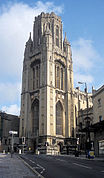
Universities and colleges in South West England Universities University colleges Further Education colleges Bath · Bicton · Bournemouth & Poole · Bridgwater · Bristol · Cirencester · Cornwall · Exeter · Filton · Gloucestershire · Hartpury · Kingston Maurward · New Swindon · Norton Radstock · Petroc · Plymouth · Plymouth Art · Somerset · South Devon · Strode · Stroud · Swindon · Truro & Penwith · Weston · Weymouth · Wiltshire · YeovilSixth form colleges Education in Bristol General Universities Academies and Free Schools Bristol Brunel Academy · Bristol Cathedral Choir School · Bristol Free School · Bristol Metropolitan Academy · City Academy · Colston's Girls · Cotham · John Cabot Academy · Merchants' Academy · Oasis Academy Brightstowe · Oasis Academy John Williams · St Bede'sCommunity and VA schools Ashton Park · Bedminster Down · Bridge Learning Campus · Brislington · Fairfield · Henbury · Orchard School · Redland Green · St Bernadette's · St Mary Redcliffe & TempleIndependent schools Andalusia Academy · Badminton · Bristol Grammar · Bristol Steiner · Carmel Christian · Clifton College · Clifton High · Colston's · Include · Prospect · QEH · Redland High · The Red Maids' SchoolSpecial schools Briarwood · Bristol Gateway · Elmfield · Greenfields · Kingsdon Manor · Kingsweston · Little Islands · New Fosseway · St Christopher's · Belgrave SchoolSixth Forms Other schools and colleges Former schools Worldwide Universities Network Australia Canada China Norway New Zealand South Africa United Kingdom Bristol • Leeds • Sheffield • Southampton • York
United States Penn State • Washington (UW) • Wisconsin–Madison
Coimbra Group of European research universities Aarhus · Barcelona · Bergen · Bologna · Bristol · Budapest · Cambridge · Coimbra · Dublin · Edinburgh · Galway · Geneva · Göttingen · Granada · Graz · Groningen · Heidelberg · Iaşi · Istanbul · Jena · Kraków · Leiden · Leuven · Louvain-la-Neuve · Lyon · Montpellier · Oxford · Padua · Pavia · Poitiers · Prague · St. Petersburg · Salamanca · Siena · Tartu · Thessaloniki · Turku I · Turku II · Uppsala · Würzburg
Russell Group of UK research universities Birmingham · Bristol · Cambridge · Cardiff · Edinburgh · Glasgow · Imperial College London · King's College London · Leeds · Liverpool · London School of Economics · Manchester · Newcastle · Nottingham · Oxford · Queen's · Sheffield · Southampton · University College London · WarwickCDIO Africa Asia-Pacific Chisholm Institute (Australia) · Queensland University of Technology (Australia) · University of Sydney (Australia) · Beijing Jiaotong University (China) · Chengdu University of Information Technology (China) · Shantou University (China) · Tsinghua University (China) · Kanazawa Technical College (Japan) · Taylor's University (Malaysia) · University of Auckland (New Zealand) · Singapore Polytechnic (Singapore) · Vietnam National University, Ho Chi Minh City (Vietnam)
Europe Hogeschool Gent (Belgium) · University College Leuven (Belgium) · Engineering College of Aarhus (Denmark) · Technical University of Denmark · Lahti University of Applied Sciences (Finland) · Metropolia University of Applied Sciences (Finland) · Seinäjoki University of Applied Sciences (Finland) · Turku University of Applied Sciences (Finland) · Telecom Bretagne (France) · Hochschule Wismar (Germany) · Politecnico di Milano (Italy) · Instituto Superior de Engenharia do Porto (Portugal) · Universitat Politècnica de Catalunya (Spain) · Chalmers University of Technology (Sweden) · Jönköping School of Engineering (Sweden) · Linköping University (Sweden) · Royal Institute of Technology (Sweden) · Umeå Institute of Technology (Sweden) · Aston University (UK) · Queen's University Belfast (UK) · University of Bristol (UK) · Lancaster University (UK) · University of Liverpool (UK) · University of Leeds (UK) · University of Strathclyde (UK)
North America École Polytechnique de Montréal (Canada) · Queen's University (Canada) · University of Calgary (Canada) · University of Manitoba (Canada) · Arizona State University (United States) · California State University (United States) · University of Colorado (United States) · Daniel Webster College (United States) · Duke University (United States) · Embry-Riddle Aeronautical University (United States) · Massachusetts Institute of Technology (United States) · University of Michigan (United States) · Pennsylvania State University (United States) · United States Naval Academy
Central and
South AmericaUniversity of Chile · Universidad Católica de la Santísima Concepción (Chile) · Universidad de Santiago de Chile (Chile) · Pontificia Universidad Javeriana (Colombia) · UNITEC Laureate International Universities (Honduras)
Categories:- Worldwide Universities Network
- University of Bristol
- Association of Commonwealth Universities
- Coimbra Group
- Educational institutions established in 1909
- Russell Group
- 1909 establishments in England
- Deaf universities and colleges in the United Kingdom
Wikimedia Foundation. 2010.


